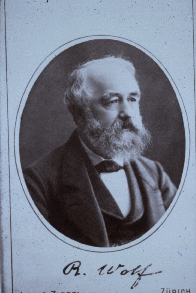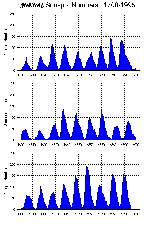A - A small single unipolar SUNSPOT or very small group of spots without PENUMBRA.
B - Bipolar sunspot group with no penumbra.
C - An elongated bipolar sunspot group. One sunspot must have penumbra.
D - An elongated bipolar sunspot group with penumbra on both ends of the group.
E - An elongated bipolar sunspot group with penumbra on both ends. Longitudinal extent of penumbra exceeds 10 deg. but not 15 deg.
F - An elongated bipolar sunspot group with penumbra on both ends. Longitudinal extent of penumbra exceeds 15 deg.
H - A unipolar sunspot group with penumbra.
 Johann Rudolph Wolf (1816-1893). Johann Rudolph Wolf (1816-1893).
National Portrait Gallery, Smithsonian Institution, Washington D.C.
In 1848 Rudolph Wolf devised a daily method of estimating solar activity by counting the number of individual spots and groups of spots on the face of the sun. Wolf chose to compute his sunspot number by adding 10 times the number of groups to the total count of individual spots, because neither quantity alone completely captured the level of activity. Today, Wolf sunspot counts continue, since no other index of the sun's activity reaches into the past as far and as continuously. An avid astronomical historian and an unrivaled expert on sunspot lore, Wolf confirmed the existence of a cycle in sunspot numbers. He also more accurately determined the cycle's length to be 11.1 years by using early historical records. Wolf, who became director of the Zurich Observatory, discovered independently the coincidence of the sunspot cycle with disturbances in the earth's magnetic field.
How Sunspot Numbers are Computed Today
An observer computes a daily sunspot number by multiplying the number of groups he/she sees by ten and then adding this product to his total count of individual spots, same way that Wolf did. Many refer to the sunspot number as a Wolf number or count (or as a Zurich Sunspot Number). Results, however, vary greatly, since the measurement strongly depends on observer interpretation and experience and on the stability of the Earth's atmosphere above the observing site. Moreover, the use of Earth as a platform from which to record these numbers contributes to their variability, too, because the sun rotates and the evolving spot groups are distributed unevenly across solar longitudes. To compensate for these limitations, each daily international number is computed as a weighted average of measurements made from a network of cooperating observatories.
 Annual Mean Sunspot Numbers 1700-1995. Annual Mean Sunspot Numbers 1700-1995.
Sunspot counts rise and fall approximately every 11.1 years. The cycle, though, is not symmetrical, for the spot count takes on the average about 4.8 years to rise from a minimum to a maximum and another 6.2 years to fall to a minimum once again. The largest annual mean number (190.2) occurred in 1957. Today, much more sophisticated measurements of solar activity are made routinely, but none has the link with the past that sunspot numbers have.
ON-LINE GLOSSARY OF SOLAR-TERRESTRIAL TERMS of National Geophysics Data Center
Sunspots are classified according to size, shape and spot density. They are classified using a set of three coded letters (Zpc) as follows:
Z - Modified Zurich class, labelled A through F plus H.
A - Single small spot (single magnetic polarity).
B - Very small distribution of small spots.
C - Two or more small spots, at least one of which has a detectable penumbra.
D - Moderately sized group of spots, several of which may have noticable penumbrae. Magnetic complexity of D-type regions are usually capable of producing C and low-intensity M-class flares.
E - Moderate to large area of a fairly complex system of sunspots, several of which have noticable penumbrae and good definition. Often capable of producing minor C-class as well as major M-class flares.
F - Large to very large area of a complex system of sunspots. These regions are often capable of producing major X-class flares as well as numerous major M-class and many C-class events (depending on their magnetic complexity).
H - Single large to very large sunspot (not usually capable of producing significant energetic events). This type of sunspot is usually manifest in the dying phase of a sunspot group.
p - Penumbra type of the largest spot in the group.
x - Single spot.
r - Rudimentary.
s - Small symmetric.
a - Small asymmetric.
h - Large symmetric.
k - Large asymmetric.
c - Relative sunspot distribution or compactness of the group.
x - Single spot.
o - Open group (separated by quite a wide space).
i - Intermediate (moderate sunspot compactness in the group).
c - Compact (very dense and complex spots within the group).
Example: A sunspot group classified as type DKO would be of moderate overall size (that is, the region encompassing all of the sunspots within the group would be of moderate size), the penumbra of the largest spot within the group would be large and asymmetric in shape, and the group would be "open" indicating that the sunspots within the region are not notably close together.
Mr. Vaino K. Lehtoranta |